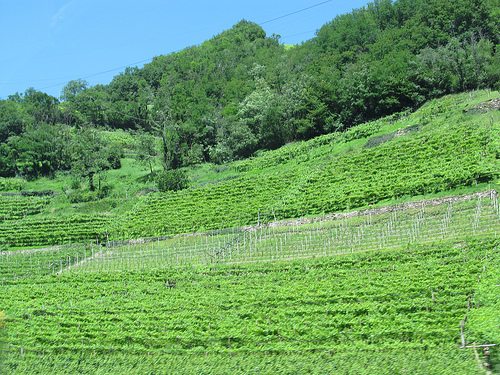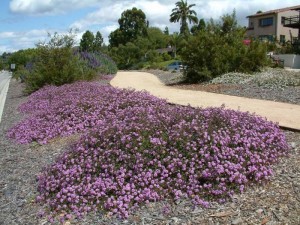Erosion Control

 Question from Ted:
Question from Ted:
I live in Temecula, California. It’s hot and dry in summer with possible light frost in winter.
I have a 100′ x 25′ south facing steep slope which needs erosion control. The soil is loose and newly deposited from our almost complete new swimming pool. Soil is mostly decomposed granite.
I am considering co-mingling Juniper Tamariscifolia “TAM”, and Lantana Montevidensis over the entire slope. I believe after a few years the Juniper will cover the entire slope and choke out the Lantana.
Does this sound like a prudent plan to you?
Answer from Pat:
Decomposed granite is excellent soil, but erosion on steep slopes must be appropriately dealt with and done as quickly as possible so roots can penetrate the slope before the rains. If the slope is new, winter rains can erode the surface and may cause slippage. Lantana montevidensis is an excellent choice of ground-cover. As I have written in detail on this blog, I advocate planting slopes with a variety of plants, some of which are larger and more deeply rooted than others. Deep-rooting choices, such as bougainvillea, can hold the bank better than simply a mat of roots on top.
If I were you I would plant Lantana montevidensis from flats, immediately or as soon as possible. You could plant your deeper-rooting shrubs at the same time or later. After planting lantana, fertilize with a pellet-type fertilizer recommended for ground covers and then irrigate daily by hand sprinkling to get it going. Move your hand sprinkling from place to place on the slope. As you see mud running off in one place, move to another then returning a few minutes later so you water enough so it sinks in. One problem you might have is that lantana is a tropical plant. It takes off sooner in warm weather than cool. Thus time is of the essence. However, on the plus side, November is the best time to plant most common ground covers.
The one part of your plan that does not sound prudent to me is your choice of Tam junipers. Junipers are prey to a whole flock of pest and disease problems, usually exacerbated when growing in a solid plantation. Some of the pests that afflict junipers include aphids, armored scale (juniper scale and minute cypress scale), bark beetles, cypress bark mealybug, cypress tip miners, flathead borers, foliage-feeding caterpillars, foliage miners, juniper twig girdler, nematodes, sawflies, and spider mites. Diseases of junipers include Armillaria root rot, canker diseases, crown rot, root rot, rusts, twig blights and wood decay. Additionally, I don’t think Tam juniper would win out against lantana in the long term and the combination of the two growing together and “fighting it out” so to speak, doesn’t sound very good looking. Though gray looks good with purple, the textures and shapes of Tam junipers and lantana are not harmonious together. Please read the discussions I’ve had with other folks who have asked me to suggest plants for holding ground on a steep slope or bank. https://patwelsh.com/wpmu/blog/planting/plant-to-prevent-erosion-on-a-steep-hillside/
Finally, here is another idea for you to consider, though it would mean a change of plans—Why not plant your bank solidly with California lilac (Ceanothus)? Choose a variety, such as Ceanothus ‘Centennial’ that grows only 2 feet tall but ten feet wide, has a smooth look due to small leaves and blooms with deep blue flowers in spring. Or visit a native plant nursery such as Tree of Life in Capistrano and take their advice on variety, planting and care. Once established you would never have to water it and November is the perfect time to plant.
Photo by ubcmicromet 
Photo by www.justgrobio.com 


I am doing a thesis of landscape with native vegetation for erosion control on slopes, I wanted to know from your perspective, which vegetation could use on slopes greater than 35% is in the city of tijuana, we count With a type of sandy soil, I have some plants like the Baccharis pilularis, Artemisia californica, Ceanothus spp. I would like it to have colors but almost what I find are shrubs, which species of fine textures could I use?
The plants you mentioned are native to California not necessarily Mexico. Mexican agaves, such as Agave attenuata provides gray green color and statuesque shape and is useful for controlling erosion on steep banks. The best and most successful landscaping for slopes combines shrubs, small trees and ground covers and can also be colorful. Consider redbud (Cercis mexicana) which provides pink to purplish blooms in late winter or early spring, with blue ceanothus orange monkey flower (Mimulus) and yellow brittle bush (Encilia farinosa.)
Blue Ceanothus next to gold Fremontedendron provides a great color splash since they bloom at the same time. Be aware that Fremontedendron cannot accept irrigation in summer or it dies. F. mexicanum is a species native to Mexico. Squirting the foliage with water can get Fremontedendrons safely through the dry summer weather since it will absorb moisture through the leaves. Spritz the leaves in the evenings of hot days, not really wetting the ground except to lay down the dust as if a light shower had fallen but not enough to penetrate the ground.